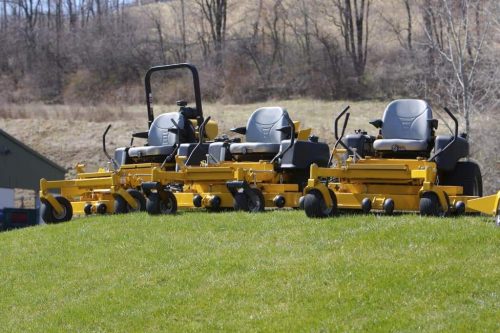Does your recently mowed lawn appear wavy and unevenly cut? Doubtlessly, something is wrong with your mower deck. With continued use, the deck loses its calibration and eventually tilts. Even the most expensive ZTRs can experience this problem. It is much more common to zero-turn mowers that are mostly used to mow uneven yards.
The good news, this is a problem that you can solve by yourself. How? You may ask. In this guide, I will show you exactly that. Let’s dive in!
8 Simple Steps to Level a Zero-turn Mower Deck
You will need:
- A measuring tape
- A pair of working gloves
- Safety glasses
- A tire pressure gauge (view on Amazon)
- Appropriate wrench/socket set (view on Amazon)
Step 1: Park your ZTR on Level Ground
When performing any maintenance routine on your residential z-turn mower, the first step is to park it on level ground. Turn the engine off. Remove the ignition key and engage the parking brakes to prevent any accidental movements.
In this particular routine, ensure that the surface is accurately level. That’s extremely crucial because you’re required to take a few measurements from the ground to the deck in the next few steps. A slightly tilted surface will compromise the accuracy of the whole process.
Step 2: Prepare your Mower
Ensure all moving parts, including the cutting blades, have come to a stop. Position the deck into its highest level and pick your preferred cutting height. Also, remove the spark plug wire to prevent it from touching the spark plug during this process.
Step 3: Check the Tire Pressure
Use your tire pressure gauge to measure the tire pressure of all the wheels. Ensure that all the tires have full pressure. Any deflated wheels may cause your mower deck to tilt, leading to inaccurate measurements during leveling.
Always consult your user manual to determine the optimum tire pressure for your particular ZTR model.
Step 4: Take the side-to-side blade measurements
Begin by lowering the deck to your desired cutting height. Next, rotate the blade nearest to the side chute such that it forms a right angle with the mower. Using your measuring tape, record the height from the ground to the right-hand side edge of this blade. Repeat this step with the left side edge.
Now get the difference between these two heights. Ideally, the difference should be equal within an acceptable error of about 1/8 inches. Otherwise, you’ll need to make a few side-to-side adjustments.
Step 5: Make the side-to-side adjustment
Locate the left link lock nut and loosen it. It is found on the front side of the left rear wheel. Please make the necessary adjustments by turning the lock nut in the clockwise direction to raise the deck’s left side or anti-clockwise to lower it.
Measure the side heights again, as explained above, and get the difference. Raise and lower the left deck until you get a height difference of zero, with an acceptable error of about 1/8 inches. Now retighten the jam nut and proceed to the next step.
Step 6: Take the front to rear blade measurements
Start by positioning the deck lift lever in one of the middle heights. Rotate the blade nearest to the side chute in a front-to-back position. It’s the same blade we used in step I above. Instead of the previous right-angle, it should be parallel to your zero-turn mower. Use a measuring tape to get the height from the tip of the blade to the ground.
Take the measurements for both the rear and front tips of the cutting blade. The difference should be within the range of 1/8 to ½ inches. Otherwise, you’ll need to make some blade adjustments.
Step 7: Make the front to rear adjustments
Begin by slightly loosening the locknut located on the end of the deck’s front hanger rod. Turning it clockwise lowers the front side of your ZTR deck while turning it anti-clockwise raises it.
Retake the blade height measurements to determine if they now fall within the 1/8 to ½ inches range. If not, repeat this step until you achieve the recommended range. Finish by tightening the jam nut you had loosened earlier.
Note: Ensure you do not interfere with the adjustment nut when fastening the locknut.
Step 8: Inspection and Evaluation
First, set the deck at its highest position. Inspect the deflectors and pulley guards to ensure they are in their best condition. Then, re-measure all the measurements you did earlier to confirm everything is in order.
Now reconnect the spark plug wire and disengage the brakes. Turn on the ignition key and test your mower. Since the deck is now level, you’ll notice a difference in your lawns. You’ll get a clean and even cut.
When Does a Zero-turn Mower Deck Need Levelling?

As a general rule of thumb, ensure that you level the deck of your z-turn mower once or twice every season. What’s more, should you notice uneven cuts or left-out strips of grass, inspect the condition of your deck. Probably, the deck has tilted and might need leveling.
Did you bump into something hard? Well, that too can cause your deck to tilt. Thus, always level your zero turn’s mower after running into obstacles.
Please note: If your ZTR’s deck is damaged or dented, leveling it may not be the ultimate solution. It shall still not function as it should. Replace it to enjoy the optimum performance of your z-turn.
Is your deck leveled, but your mower still leaves uncut strips of grass? Check for other causes of uneven cuts in zero-turn mowers. The most common reasons are speeding, a dirty deck, damaged blades, using an extremely low cutting height, low engine speed, worn drive belt, or inadequate overlapping.
In Conclusion
Leveling a z-turn mower deck is a straightforward process. You can do it yourself without requiring any extra hand. Park the mower on level ground. Switch off the engine and engage the parking gear. Now follow the steps I have shared above on how to level a zero-turn mower deck for a beautiful and evenly cut lawn.
